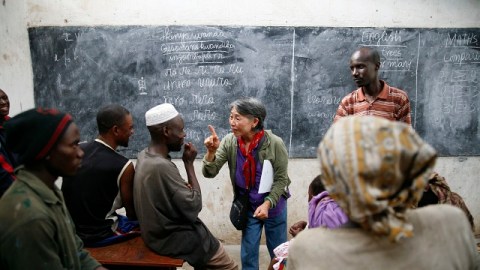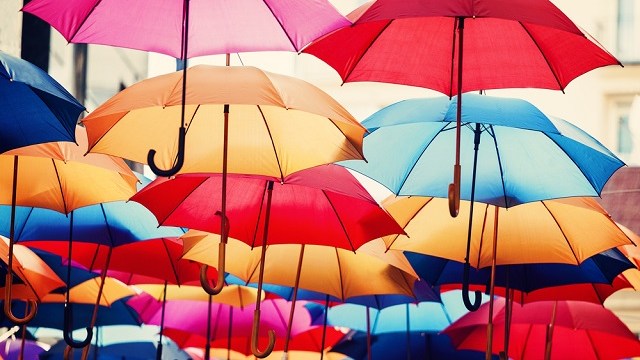How Making Art Can Rebuild Broken Communities

“The broken places are my canvases,” Artist Lily Yeh says in the documentary The Barefoot Artist. “People’s stories are my pigments. People’s talents and imaginations are the instruments. I began to find my voice.” Since the 1980s, Yeh has taken her talents to places around the world broken by poverty or war and rebuilt those communities through the making of communal art. Through what eventually grew into the organization Barefoot Artists, Yeh “breathe[s] life, beauty, rhythm, and joy into th[ose] space[s]” that “beckon” to her as the “forgotten” homes of “traumatized people.” The directing team of Glenn Holsten and Daniel Traub (who is also Yeh’s son) have followed Yeh’s work since 1988 and provide an inspiring film that is sometimes painful in its honesty but always as hopeful as Yeh’s unyielding faith in the power of art to restore the individual spirit and rebuild shattered communities.
The Barefoot Artist moves back and forth through time to tell two interconnected stories: the story of Yeh’s life, from her youth in China and to her development as an artist in the United States, as well as the story of how her international projects saved not only the people of those communities, but also Yeh herself. “I didn’t go there to help people. I was the one who needed help,” Yeh confesses. “I came from a broken place. Life breaks all of us.” Yeh’s brokenness comes from her father’s impulsive decision to leave his first wife and their children to marry Yeh’s mother. Although Yeh’s father, a dashing officer in the Chinese army, and Yeh’s mother, a member of the upper class, soon discover their incompatibility after the initial infatuation wears off, they remain together in their own broken way and leave that abandoned first family to face the wrath of the Communist party retaliating against the father’s involvement in the pre-Mao army. Yeh eventually came to America to pursue art, married tragically young as well, and struggled to balance the challenges of a career and family, including her young son and her aging father as he faced Alzheimer’s disease.
“I often felt that I had to live two persons’ lives,” Yeh says of her need not only to find her voice as an artist, but also to somehow realize the failed promise of her father’s life, which seems like one slow decline after his glory days defending his homeland during the Sino-Japanese War. Along the way, Yeh’s own marriage unravels. Later, she places a large share of the burden of caring for her ill father on her much-too-young son. Knowing that her son Daniel is working behind the camera as they discuss their family history can be painful for the viewer, but the overall effect of honesty and sharing is so beautifully overwhelming that it’s worth the discomfort to see how, as Yeh later says, “Tranquility is right at the edge of the chaos.” Just as Yeh walks barefoot through her and her son’s dark times to reach the light of peace, she strives to make amends to her father’s first family by returning to China and sharing her father’s diaries with her half-siblings. The whole history of the twentieth century is one of war and division, but Yeh allows her family’s specific history to serve as a case study not just of how lives were broken, but also how lives can be rebuilt regardless of the passage of time or distances between borders.
Interspersed with that personal family story are scenes from Yeh’s travels around the world to rebuild communities through art. In 1986, Arthur Hall, founder of the Afro-American Dance Ensemble, asked Yeh to create a park in the abandoned lot next to his studio in North Philadelphia. Through archival footage, we see Yeh work with local children and adults to create mosaic murals and sculpted trees. That park eventually becomes The Village of Arts and Humanities, which took the concept of that original project and brought it to similar communities facing the blight of poverty and the war-like conditions of urban crime who sorely needed the grace and beauty of Yeh’s art. It’s almost too symbolic the way that Yeh and the children break up pottery into shards so as to reassemble the pieces into mosaics. Similarly, when Yeh outlines the bodies of women who survived the Rwandan genocide of 1994, the symbolism of celebrating and affirming their physical survival is too powerful for words. At the Rwanda Genocide Survivor’s Village in Rugerero, Rwanda, Yeh provides art materials to the women who survived countless horrors to allow them to tell their story. “We were drawing and releasing our sadness,” one survivor says. “After finishing the drawing, I felt the heaviness leave my heart, and I wanted to keep drawing!” When Yeh works with the locals to turn the shed-like mass grave of those killed during the genocide into a Genocide Memorial Park, full of color and creativity, you get the full effect of the power of Yeh’s artistic practice. “It was like killing us twice,” one local says of the earlier mass grave. Although the memorial park doesn’t bring the dead back, it does allow the living to live again, never free of the memories, of course, but now inspired by the possibility of transformation.
In Korogocho, Kenya, a settlement built beside an immense trash dump, Yeh worked with locals on a mural titled Warrior Angel. As The Barefoot Artist proves, Lily Yeh herself is a “warrior angel.” Her angelic smile and spritely, child-like optimism coexist perfectly with the warrior within working long hours as an advocate for these forgotten, broken places and people. She quotes her military father as once saying, “To lead soldiers, one must lead their hearts.” Likewise, to lead these people to create these communal art projects, Yeh first leads their hearts—a general with a paintbrush. It’s a cruel irony that Yeh works in some of the hardest dust-bitten places in Africa to create those artistic oases Chinese landscape painting calls the “dustless places.” But it’s precisely in those neglected, dusty corners that such work is most direly needed. The Barefoot Artist is like a spring cleaning of the soul, a breath of fresh air that will restore your belief in the restorative power of art.
[Image: Artist Lily Yeh talking to residents of Rwanda Genocide Survivor’s Village in Rugerero, Rwanda.]
[Many thanks to the makers of The Barefoot Artist for providing me with the image above and other materials related to the film. The trailer for the film can be seen here. A list of upcoming screenings can be found here. You can purchase the DVD here.]





